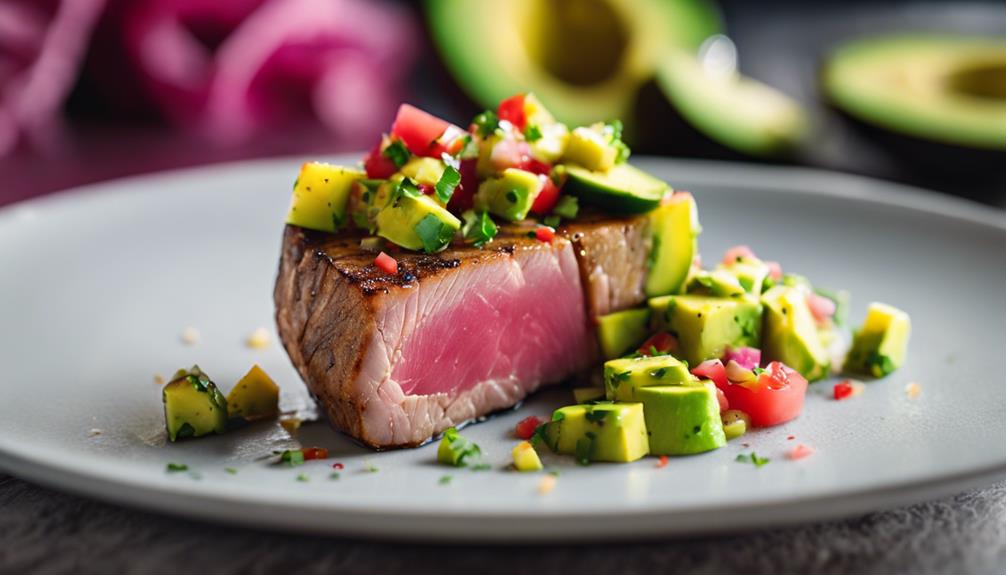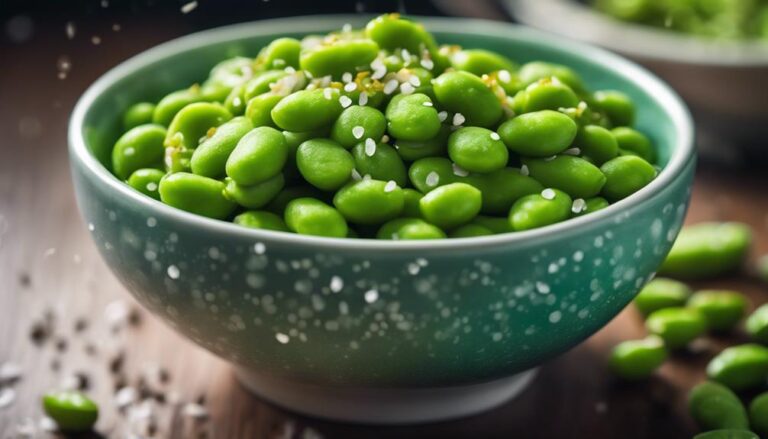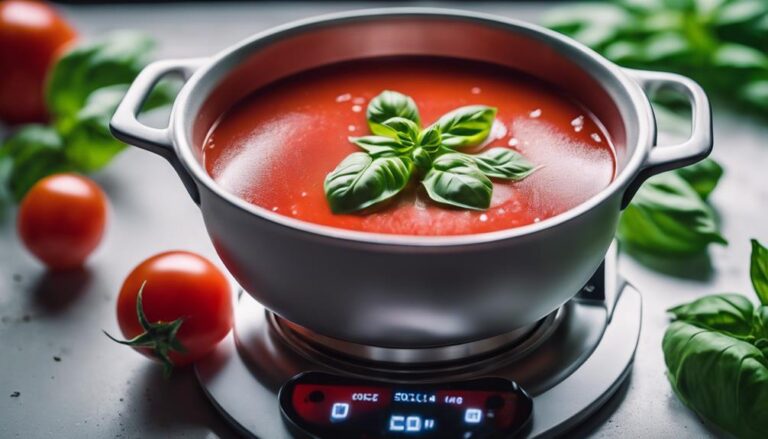Lunch Sous Vide Tuna Steak With Avocado Salsa
Elevate your lunch with a sous vide tuna steak paired with zesty avocado salsa. Seal seasoned tuna in a bag, cook in a water bath for precise tenderness. Mix diced avocado, tomato, onion, cilantro, lime juice for a invigorating topping. Sear tuna for a golden crust before adding the salsa. Enjoy a harmony of flavors and textures in every bite. Discover more about tuna's culinary potential and creative recipes to enhance your dining experience.
What You Will Learn Here
- Sous vide cooking ensures a perfectly tender tuna steak.
- Avocado salsa adds a creamy, flavorful contrast to the tuna.
- Precision temperature control is crucial for sous vide cooking.
- Season tuna steak with complementary herbs and spices.
- Searing the tuna briefly after sous vide adds a crispy exterior.
Tuna's Culinary Evolution
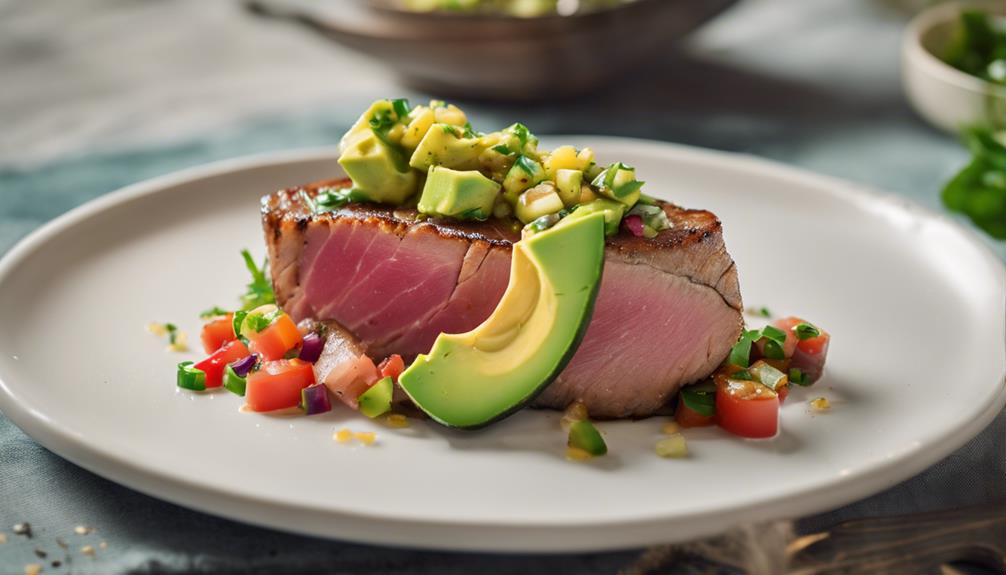
Tuna's culinary journey spans various flavor profiles, cooking techniques, and its prominence in popular cuisines around the world.
From its delicate taste in sashimi to its robust flavor when seared, tuna offers a versatile canvas for culinary exploration.
Comparing different cooking methods sheds light on how this fish adapts to diverse culinary traditions.
Tuna's Flavor Profiles
Exploring the diverse flavor profiles of tuna reveals its intriguing culinary evolution. When considering tuna's flavor, think about its pairing options and how they create delightful flavor contrasts. Tuna's mild taste pairs well with bold flavors like citrus, soy sauce, or ginger. These combinations elevate the tuna's natural essence, creating a harmonious blend of tastes.
Experimenting with different seasoning techniques can reveal tuna's full potential. Enhance its umami notes by using ingredients like miso, sesame oil, or even a sprinkle of seaweed flakes. These additions deepen the flavor complexity, making each bite a memorable experience.
Tuna's culinary journey has evolved to incorporate various methods that enhance its taste while preserving its delicate nature. By understanding these flavor profiles and experimenting with different combinations, you can truly appreciate the versatility of tuna in creating exquisite dishes like the Sous Vide Tuna Steak with Avocado Salsa.
Cooking Techniques Comparison
Comparing cooking techniques highlights the evolution of tuna's culinary journey, showcasing the innovative methods that have enhanced its flavors over time. When considering grilling versus sous vide preparation, grilling imparts a smoky char while preserving the tuna's natural juices. On the other hand, sous vide cooking involves vacuum-sealing the fish and cooking it slowly in a precisely controlled water bath, resulting in a tender and evenly cooked tuna steak.
In the domain of pan searing versus poaching, pan searing quickly caramelizes the exterior of the tuna, creating a flavorful crust while maintaining a moist interior. Poaching, a gentler technique, involves cooking the tuna in liquid at low temperatures, ensuring a delicate texture and subtle taste. Each method offers a unique culinary experience, allowing you to tailor the cooking process to your desired outcome. Whether you prefer the seared intensity of a pan or the gentle poaching touch, the choice of cooking technique can greatly influence the final taste and texture of your tuna dish.
Tuna in Popular Cuisines
Delving into various global cuisines reveals the diverse ways in which tuna has evolved in culinary practices. In Japanese cuisine, tuna is a star ingredient seen in sushi variations like maguro nigiri and spicy tuna rolls. Tuna's popularity in sushi highlights its versatility, from delicate sashimi to flavorful maki rolls.
Beyond Japan, tuna tartare has become a staple in Western fine dining, showcasing the fish in a raw, finely chopped form seasoned with herbs and spices. This dish offers a fresh take on tuna, appealing to those who enjoy raw preparations.
As global demand for tuna rises, concerns about its sustainability have also come to the forefront. Overfishing has threatened tuna populations, leading to initiatives promoting responsible fishing practices. It's essential for consumers to be mindful of where their tuna comes from and choose suppliers committed to sustainable sourcing.
Tuna's Key Marinade Ingredients
To enhance the flavor of your tuna steak, the key marinade ingredients play an essential role in creating a delicious dish. Here are some marinade secrets and flavor combinations to take your tuna to the next level:
- Soy Sauce: Adds a savory umami flavor that complements the natural taste of the tuna.
- Citrus: Whether it's lemon, lime, or orange juice, citrus adds a bright acidity that cuts through the richness of the fish.
- Garlic: Provides a pungent kick that enhances the overall depth of flavor.
- Ginger: Offers a warm, spicy note that pairs wonderfully with the tuna's meaty texture.
Tasty Tuna Creations
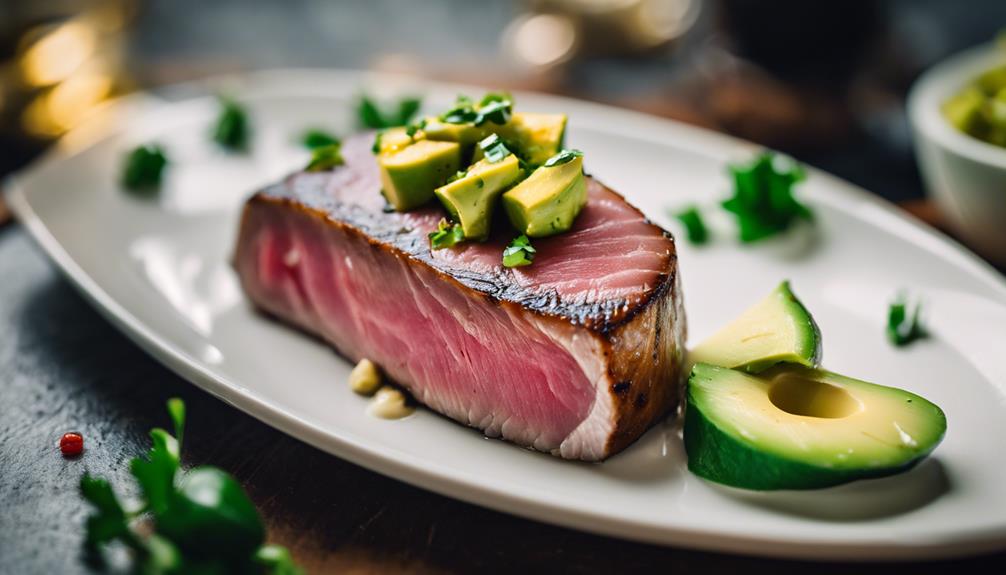
When it comes to tasty tuna creations, you have a plethora of options to explore. From the succulent Sous Vide Tuna Steak to the flavorful Sesame-Crusted Tuna Delight and the invigorating Seared Tuna Nicoise Salad, there's a dish to suit every palate.
Whether you prefer your tuna grilled, seared, or raw in a salad, there's a delicious tuna creation waiting for you to try.
Sous Vide Tuna Steak
For a succulent and flavorful tuna steak, consider trying the sous vide cooking method for your next culinary adventure. Sous vide cooking offers an excellent way to achieve the perfect tuna texture while benefiting from its advantages:
- Precise Temperature Control: Sous vide guarantees your tuna steak is cooked to the exact temperature you desire, resulting in a tender and moist texture.
- Enhanced Flavors: By sealing the tuna in a vacuum bag during sous vide cooking, the flavors are sealed in, creating a more intense and delicious taste.
- Consistent Results: With sous vide, you can consistently achieve the ideal doneness throughout the entire tuna steak, eliminating the risk of overcooking.
- Minimal Hands-On Time: Once you've set up the sous vide machine and temperature, you can let it work its magic while you attend to other tasks, making it a convenient cooking method.
Try sous vide cooking for your next tuna steak, and experience the delightful texture and flavors it brings to this delectable dish.
Sesame-Crusted Tuna Delight
Try enhancing your tuna dining experience with a tantalizing Sesame-Crusted Tuna Delight that will elevate your taste buds to new heights.
Here are some tips to make your tuna creation a true delight:
- Searing Tips: Achieve a perfect sear by patting the tuna dry before coating it with sesame seeds. Make sure your pan is hot before adding the tuna to get that crispy crust.
- Seasoning Secrets: Enhance the flavor of your sesame-crusted tuna by seasoning it with a mix of salt, pepper, and a touch of garlic powder. This simple seasoning blend will complement the nuttiness of the sesame seeds.
- Sous Vide Benefits: Consider using the sous vide method to pre-cook the tuna to the perfect temperature before searing. This technique guarantees a tender and evenly cooked tuna steak.
- Marinade Magic: Infuse your tuna with flavor by marinating it in a blend of soy sauce, ginger, and a hint of honey. Let the tuna soak up the marinade for a few hours before coating it with sesame seeds for a delicious result.
Seared Tuna Nicoise Salad
Elevate your tuna culinary repertoire with the vibrant flavors of a Seared Tuna Nicoise Salad, a delightful addition to your Tasty Tuna Creations journey.
- Fresh Ingredients: Start with high-quality seared tuna, mixed greens, boiled eggs, cherry tomatoes, and Kalamata olives.
- Flavorful Dressing: Drizzle a classic vinaigrette made with olive oil, Dijon mustard, and red wine vinegar over the salad for a tangy kick.
- Perfectly Seared Tuna: Sear the tuna briefly on each side to create a crispy exterior while keeping the inside tender and pink.
- Assembly: Arrange the tuna slices on a bed of greens, surrounded by the eggs, tomatoes, and olives. Finish with a sprinkle of capers and a drizzle of dressing.
This Seared Tuna Nicoise Salad combines the richness of seared tuna with the freshness of vegetables and the tang of the dressing, creating a harmonious dish that's both satisfying and nutritious. Enjoy the burst of flavors in every bite!
Tuna Searing Techniques
When searing tuna, remember to achieve a high heat for a flavorful crust.
Control the temperature carefully to prevent overcooking and maintain the tuna's tenderness.
Experiment with different flavor enhancement methods to elevate the taste of your tuna steak.
Searing for Tuna
For perfectly seared tuna, make sure your pan is preheated to high heat before adding the fish. Searing tips are vital for achieving that mouthwatering crust on the outside while keeping the inside tender and juicy. When searing tuna, opt for high-quality olive oil or sesame oil for a delightful flavor pairing that complements the fish's richness.
To guarantee searing perfection, pat the tuna steak dry before placing it in the hot pan. This step helps in achieving a beautiful sear without excess moisture hindering the process. Remember not to overcrowd the pan; give each piece of tuna enough space for proper searing.
Aim for a quick sear on each side, usually around 1-2 minutes per side, depending on the thickness of the tuna steak. This short cooking time helps maintain the tuna's delicate texture. Embrace the sizzle and aroma as you sear, knowing that your tuna steak will soon be ready to delight your taste buds.
Temperature Control Tips
To guarantee ideal searing outcomes when preparing tuna, mastery of temperature control techniques is essential for achieving that perfect crust while preserving the fish's tenderness. Precision cooking is vital when it comes to searing tuna steaks. Ensuring temperature accuracy throughout the cooking process will help you achieve that desired balance between a beautifully seared exterior and a tender, moist interior.
When it comes to searing tuna, one of the key temperature control tips is to preheat your pan properly. Make sure your pan is hot before adding the tuna steak to ensure a quick sear. Additionally, using a high smoke point oil such as grapeseed or avocado oil can help maintain the necessary cooking temperature without burning.
Another tip for temperature control is to avoid overcrowding the pan. Cooking the tuna steak in batches if needed will help maintain the heat level and prevent the fish from steaming instead of searing. By mastering these temperature control techniques, you can elevate your tuna searing skills and create a deliciously seared tuna steak with a perfect crust every time.
Flavor Enhancement Methods
Curious how to enhance the flavor of your seared tuna steak using innovative techniques? When it comes to searing tuna, there are several methods you can employ to elevate its taste. Seasoning tips play an important role in enhancing the flavor profile of your tuna. Consider using a blend of spices like black pepper, garlic powder, and a touch of paprika to add depth to your seared tuna.
Brining benefits can also work wonders for your tuna steak. A simple saltwater brine can help infuse moisture and flavor into the tuna, making it juicier and more flavorful when seared. Additionally, infusion methods like marinating your tuna in a mixture of soy sauce, ginger, and sesame oil can impart a rich umami flavor that pairs perfectly with the fish.
Exploring brisket secrets, such as using a combination of low and high heat to sear your tuna quickly while maintaining its tenderness, can result in a perfectly seared exterior with a moist and flavorful interior. Experimenting with these flavor enhancement techniques will take your seared tuna steak to the next level.
Final Thoughts
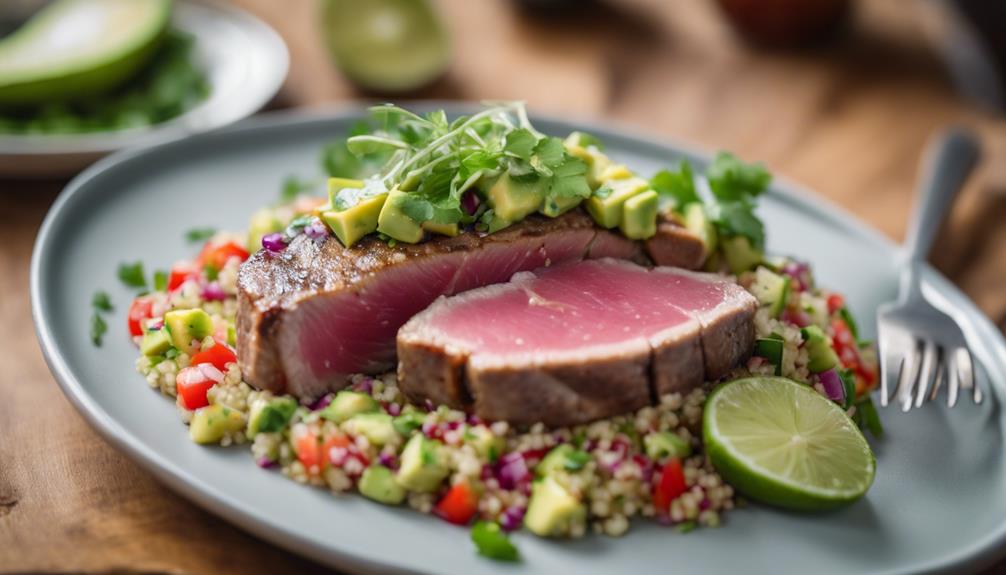
Consider reflecting on your experience with this Sous Vide Tuna Steak with Avocado Salsa dish to fully appreciate its flavors and textures. As you conclude your culinary exploration of this meal, take a moment to think about the reflections it has sparked.
Did the tender tuna steak cooked to perfection through sous vide surprise you with its juiciness? How did the creamy avocado salsa complement the rich flavors of the fish, adding a revitalizing twist to each bite?
In your final thoughts, you might find yourself reminiscing about the contrast between the warm, succulent tuna and the cool, zesty salsa. Perhaps this dish has inspired you to explore further into the world of sous vide cooking or experiment with different salsa variations.
Your journey with this recipe not only satisfied your taste buds but also opened doors to new culinary possibilities. Remember, the joy of cooking lies not only in the delicious results but also in the process of discovery and creativity. Embrace these reflections and let them guide you in future gastronomic adventures.
Frequently Asked Questions
Can I Substitute Tuna With Another Type of Fish?
If you're considering fish alternatives, remember that various types work well in sous vide recipes. Adjust cooking times based on the fish's thickness. Experiment with salmon, halibut, or swordfish for a delicious twist. Enjoy exploring new flavors!
Is It Safe to Eat Tuna Steak Rare?
Eating tuna steak rare can pose food safety risks due to potential bacterial contamination. It's recommended to cook tuna thoroughly to reduce health risks. However, culinary preferences vary, and some may enjoy the taste of rare tuna despite the potential health concerns.
How Do I Know When Tuna Steak Is Cooked?
To determine tuna doneness, focus on texture. Use sous vide techniques for precise timing. Look for a firm but still tender texture. A slight pink center indicates rare, while fully opaque means well-done.
Are There Any Vegetarian Alternatives for This Recipe?
For a meatless option, consider using plant-based alternatives like marinated tofu or tempeh in place of tuna steak. These substitutes can be cooked similarly and paired with avocado salsa for a flavorful vegetarian dish.
Can I Use Frozen Tuna for This Dish?
Yes, you can use frozen tuna for this dish. Just make sure it's properly thawed before cooking. While fresh tuna is preferred for sous vide, frozen tuna can work well too, although grilling techniques might vary slightly.
Conclusion
Overall, sous vide tuna steak with avocado salsa is a delicious and nutritious meal that can be easily prepared at home.
By marinating the tuna with key ingredients and searing it to perfection, you can elevate the flavors and textures of this dish.
Whether you're a seafood enthusiast or looking to try something new, this recipe offers a tasty and satisfying option for lunch or dinner.
Enjoy the culinary evolution of tuna in your own kitchen!
